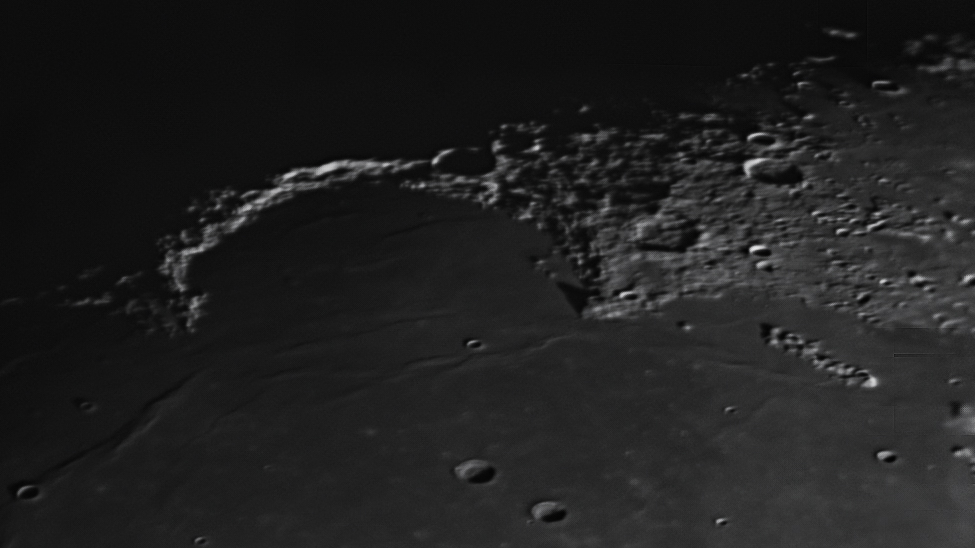Night sky, July 2025: What you can see tonight [maps]
Find out what's up in your night sky during July 2025 and how to see it in this Space.com stargazing guide.

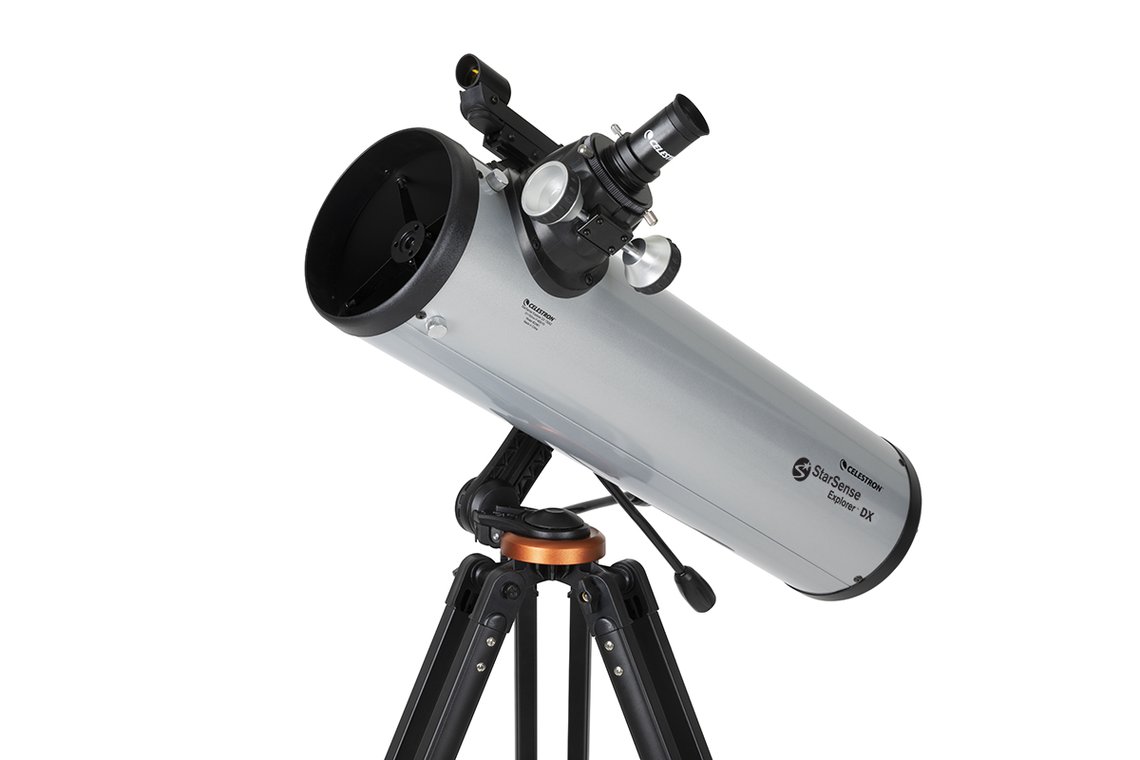
Looking for a telescope for the next night sky event? We recommend the Celestron StarSense Explorer DX 130AZ as the top pick for basic astrophotography in our best beginner's telescope guide.
The night sky tonight and on any clear night offers an ever-changing display of fascinating objects you can see, from stars and constellations to bright planets, the moon, and sometimes special events like meteor showers.
Observing the night sky can be done with no special equipment, although a sky map can be very useful, and a good telescope or binoculars will enhance some experiences and bring some otherwise invisible objects into view.
You can also use astronomy accessories to make your observing easier, and use our Satellite Tracker page powered by N2YO.com to find out when and how to see the International Space Station and other satellites. We also have a helpful guide on how you can see and track a Starlink satellite train.
You can also capture the night sky by using any of the best cameras for astrophotography, along with a selection of the best lenses for astrophotography.
Read on to find out what's up in the night sky tonight (planets visible now, moon phases, observing highlights this month) plus other resources (skywatching terms, night sky observing tips and further reading)
Related: The brightest planets in the night sky: How to see them (and when)
Monthly skywatching information is provided to Space.com by Chris Vaughan of Starry Night Education, the leader in space science curriculum solutions. Follow Starry Night on Twitter @StarryNightEdu and Chris at @Astrogeoguy
Editor's note: If you have an amazing skywatching photo and would like to share them with Space.com's readers, send your photo(s), comments, and your name and location to spacephotos@space.com.
Calendar of observing highlights
Wednesday, July 2 - First Quarter Moon

The moon will complete the first quarter of its orbit around Earth, measuring from the previous new moon, on Wednesday, July 2 at 3:30 p.m. EDT or 12:30 p.m. PDT, which converts to 19:30 GMT. The 90-degree angle formed by the Earth, sun, and moon at that time will cause us to see our natural satellite half-illuminated on its eastern side. At first quarter, the moon always rises around midday and sets around midnight, allowing it to be seen in the afternoon daytime sky, too. The evenings surrounding the first quarter phase are the best ones for viewing the lunar terrain when it is dramatically lit by low-angled sunlight.
Wednesday, July 2 - See the Lunar X and V (peaks at 9 p.m. EDT)
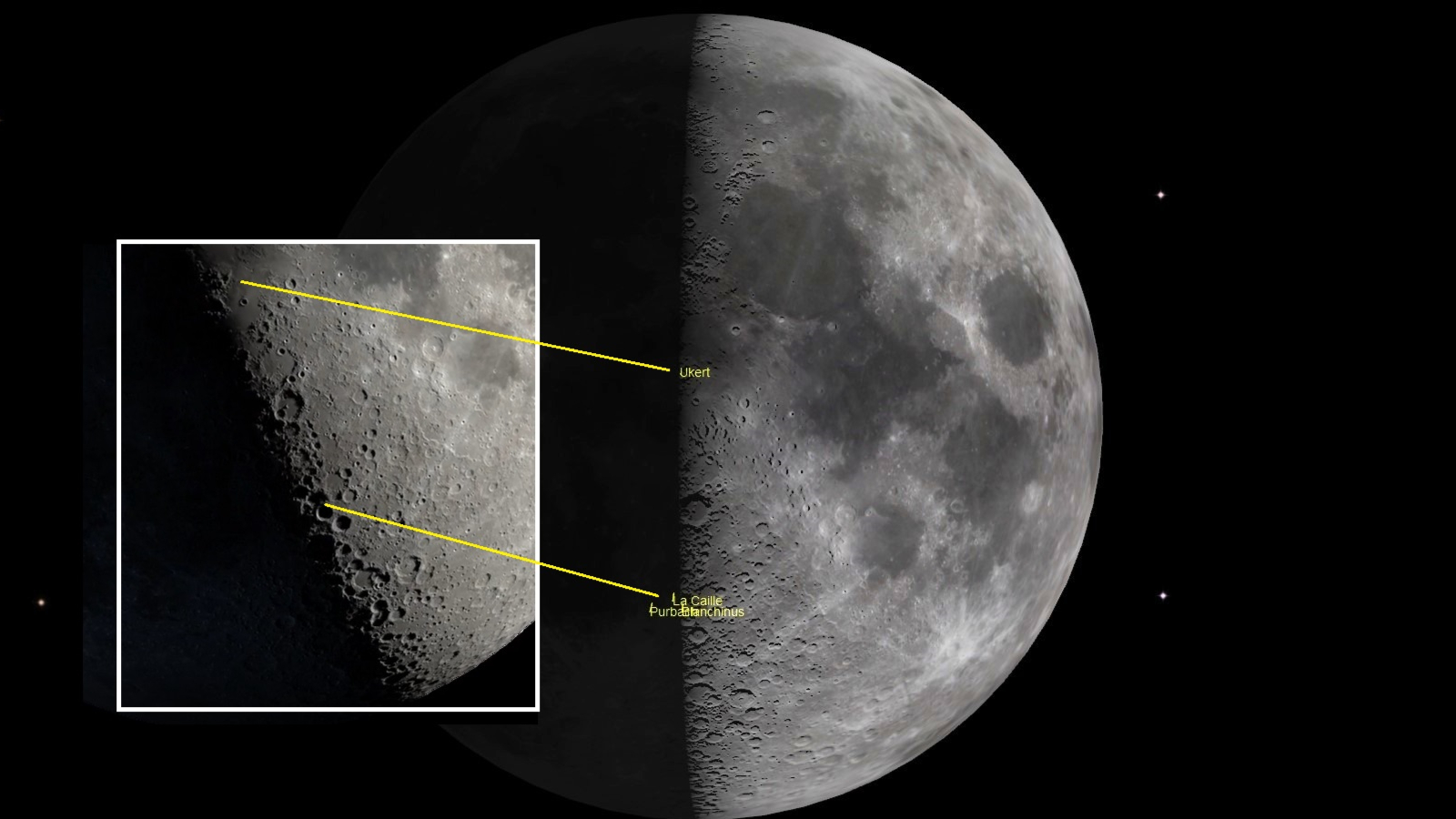
Several times a year, near the moon's first quarter phase, small clair-obscur effect features on the moon called the Lunar X and the Lunar V become visible in strong binoculars and backyard telescopes for a few hours. The Lunar X, a prominent X-shaped pattern, appears when the rims of the craters Purbach, la Caille, and Blanchinus are illuminated from a particular angle of sunlight (inset). Look for it beside the terminator about one-third of the way up from the southern pole of the Moon. The Lunar V forms along the northern span of the terminator near the crater Ukert. On Wednesday, July 2, the features are predicted to start developing by about 9 p.m. EDT (or 01:00 GMT on Thursday, July 3), peak in intensity at around 10:15 p.m. EDT (or 0215 GMT on July 3), and then gradually fade out toward midnight Eastern time. The event will occur during waning daylight for observers in western North America, but you can observe the moon in a telescope during the daytime, as long as you take care to avoid aiming it near the sun. The Lunar X will be visible anywhere on Earth where the moon is shining, especially in a dark sky, between 01:00 and 04:00 GMT on July 3.
Thursday, July 3 - Earth at Aphelion

On Thursday, July 3, at 4:00 p.m. EDT, 1:00 p.m. PDT, or 20:00 GMT, Earth will reach aphelion, its greatest distance from the sun for this year. Aphelion's 94.51 million miles (152.09 million km) distance is 1.67% farther from the sun than the mean Earth-sun separation of 92.96 million miles (149.6 million km), which is also defined to be 1 Astronomical Unit (1 A.U.). Seasonal temperature variations arise from the Earth's axis of rotation tilting towards and away from the sun, and not from our distance from the sun. Earth will reach its minimum distance from the sun, or perihelion, on January 4, 2026.
Thursday, July 3 - Mercury at greatest eastern elongation near the Beehive (after sunset)

After sunset on Thursday evening, July 3, Mercury (orbit shown in red) will stretch to its widest separation of 25.9 degrees east of the sun, and its maximum visibility, for its current apparition. This appearance of the planet will be reasonably good for both Northern Hemisphere and Southern Hemisphere observers. The optimal viewing time at mid-northern latitudes will commence around 9 p.m. local time. Viewed in a telescope (inset) the planet will exhibit a waning, nearly half-illuminated phase. As the sky darkens, watch for the scattered stars of the Beehive cluster, aka Messier 44, spread out to Mercury's upper right (or celestial north), and Cancer's medium bright star Delta Cancri shining to Mercury's upper left (or celestial east). Mercury will pass very close to that star on the following evening, July 4.
Thursday, July 3 - Gibbous moon slides by Spica (evening)
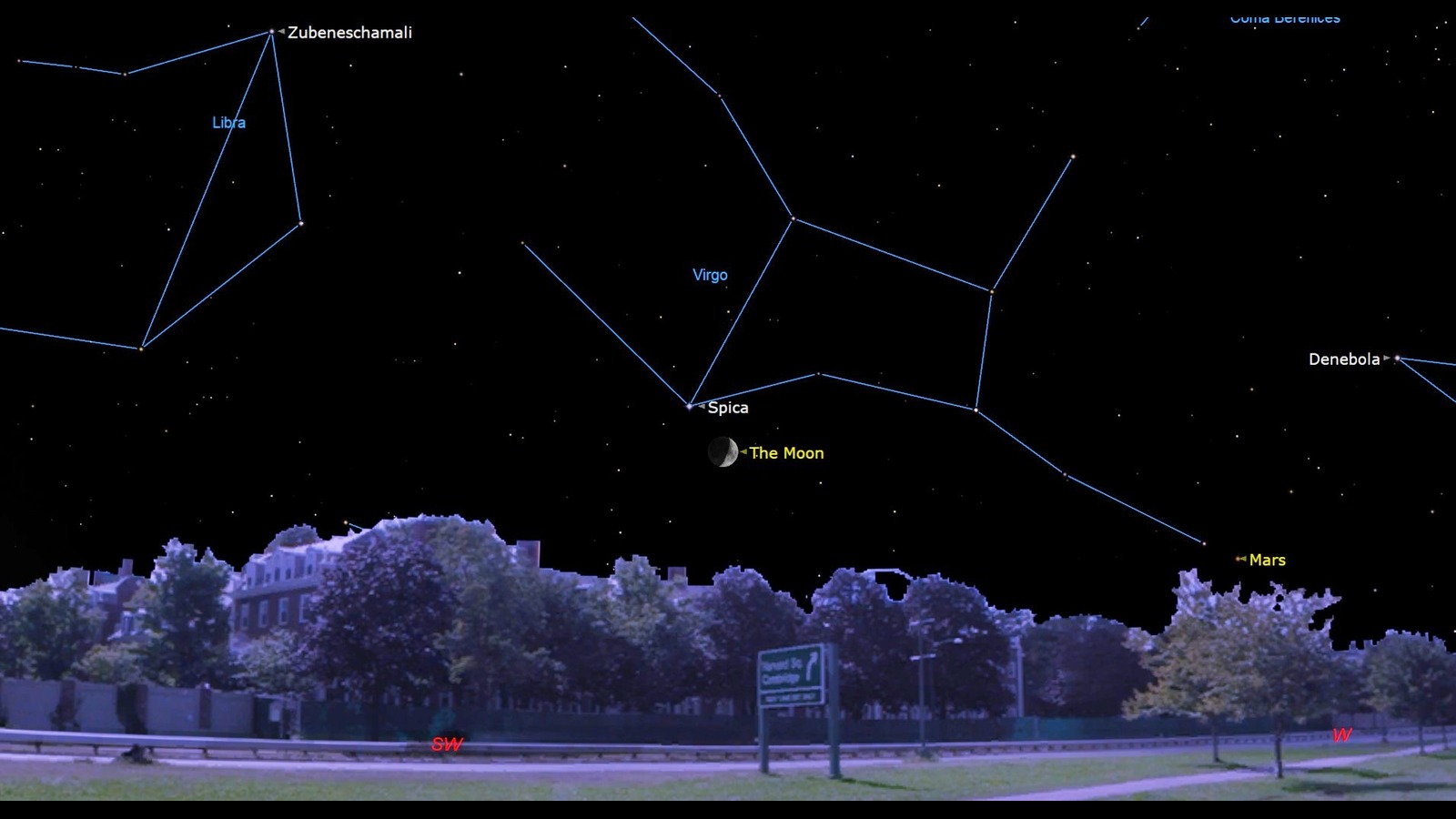
When the sky darkens after dusk on Thursday, July 3, Virgo's brightest star Spica will appear just to the upper right of the waxing gibbous moon in the southwestern sky. Until they set after midnight, the duo will share the view in binoculars (orange circle). Observers viewing the pair later, or in more westerly time zones, will see the moon's easterly orbital motion carry it farther from the star. Hours earlier, that motion will cause the moon to pass in front of Spica for skywatchers located at the extreme southern end of South America and most of Antarctica.
Friday, July 4 - Venus passes Uranus (pre-dawn)
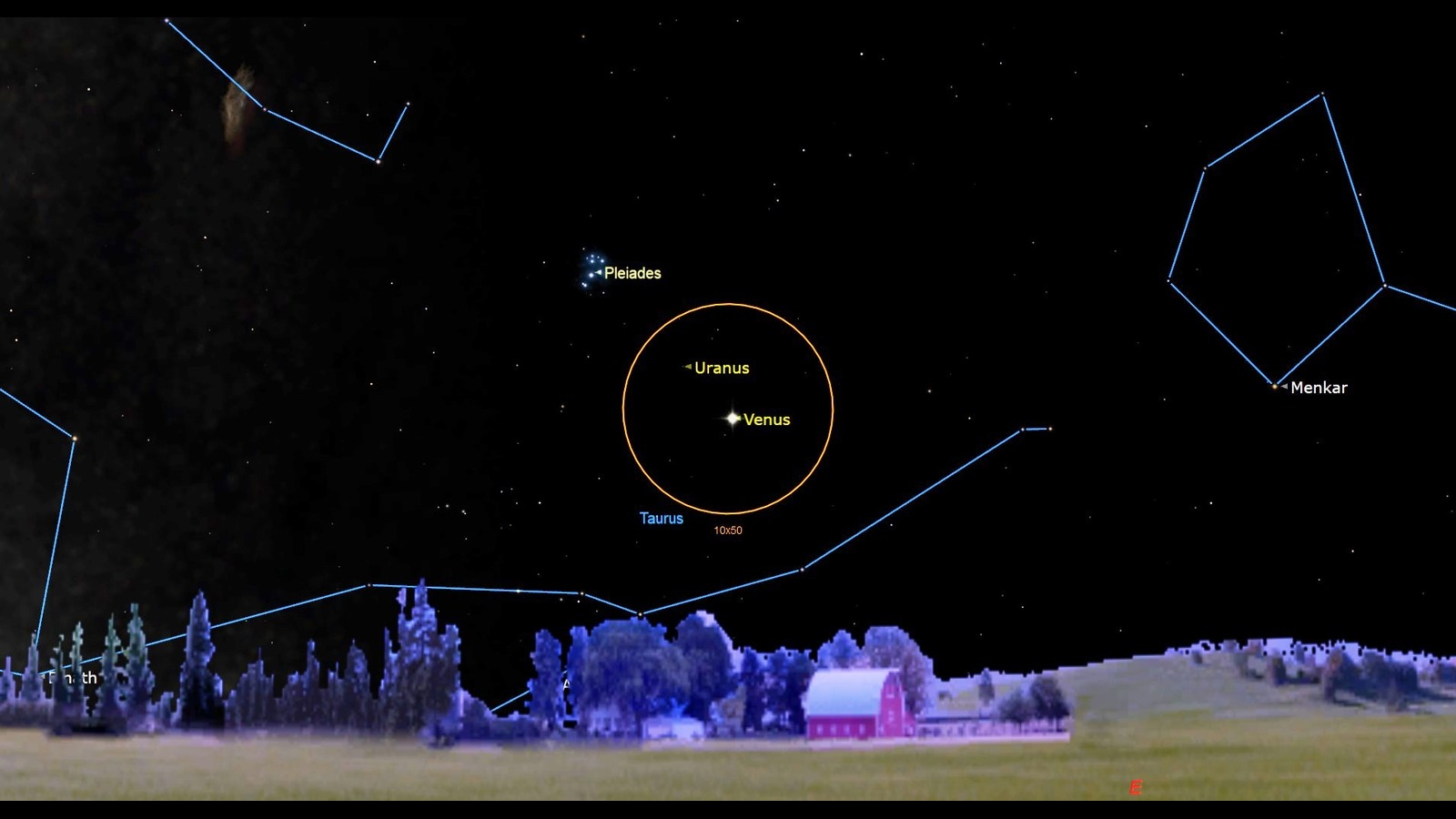
The brilliant planet Venus will dominate the eastern predawn sky for most of this year while it slowly swings back toward the sun. On the mornings surrounding Friday, July 4, Venus will pass close enough to Uranus to allow early risers to use Venus to locate the far fainter planet in binoculars (orange circle). On the previous mornings, the magnitude 5.8, blue-green speck of Uranus will shine several finger widths to Venus' left (or 3.5 degrees to its celestial northeast). At their closest approach on Friday, the distant planet will be about half that distance to Venus' upper left (or celestial north). From Saturday onward, Uranus will shift farther above Venus, but they will share the view in binoculars until about July 9. Watch for the bright Pleiades star cluster above Uranus.
Saturday, July 5 - Sinus Iridum's Golden Handle (evening)
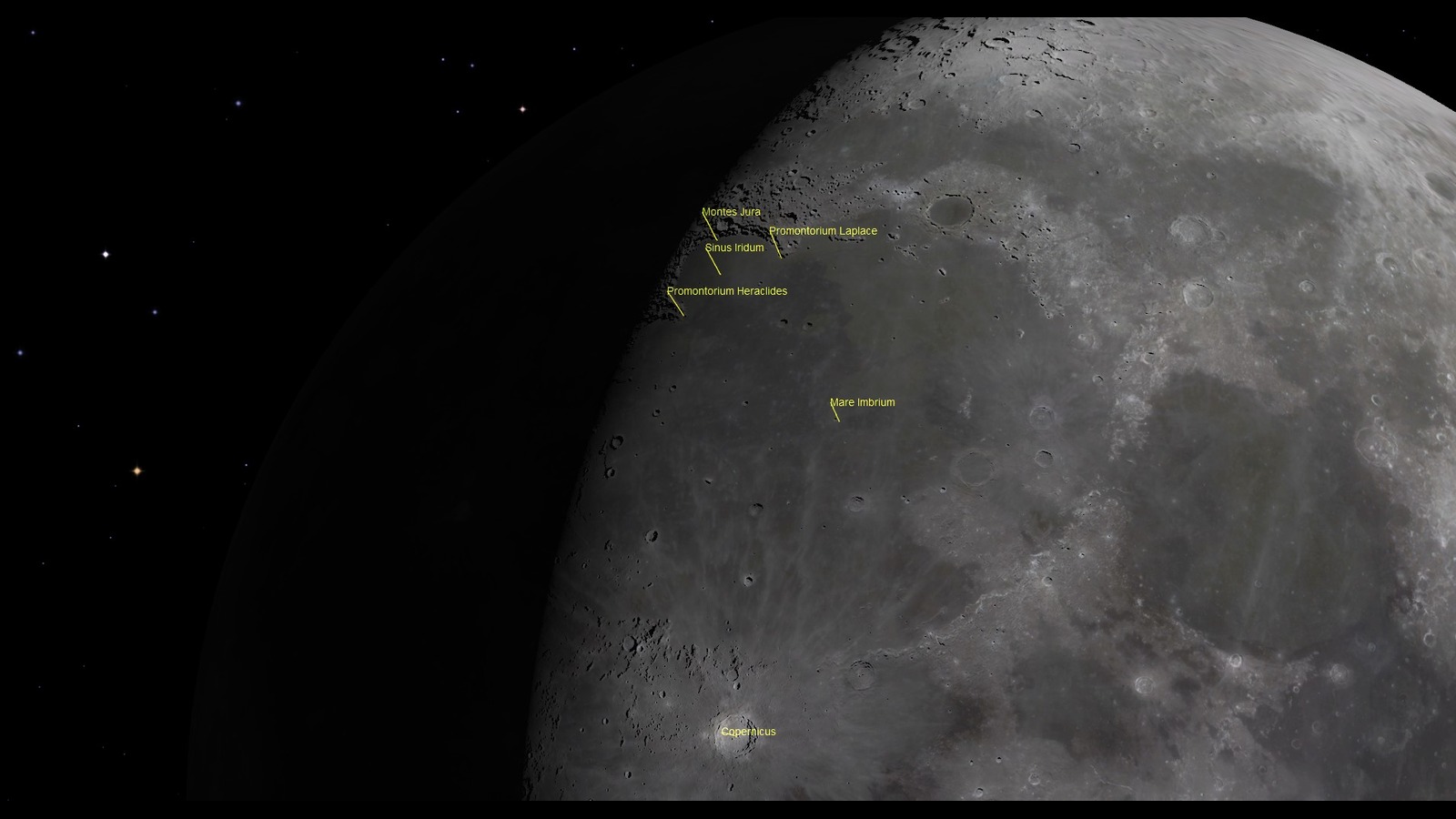
On Saturday night, July 5, the terminator on the waxing gibbous moon will fall just west of Sinus Iridum, the Bay of Rainbows. The circular 155-mile (249 km) diameter feature is a large impact crater that was flooded by the same basalts that filled the much larger Mare Imbrium to its east, forming a rounded handle-shaped feature on the western edge of that mare. The "Golden Handle" effect is produced by the way the slanted sunlight brightly illuminates the eastern side of the prominent Montes Jura mountain range surrounding the bay on the north and west, and by a pair of protruding promontories named Heraclides and Laplace to the south and north, respectively. Sinus Iridum is almost craterless, but hosts a set of northeast-oriented dorsae or "wrinkle ridges" that are revealed at this phase.
Monday, July 7 - Bright moon follows Antares (overnight)

In the southern sky after dusk on Monday, July 7, the prominent reddish star Antares will be twinkling several finger widths to the right of the bright, waxing gibbous moon. By the time Antares sets ahead of the moon, at around 2:30 a.m. local time, the rotation of the sky will have shifted it lower than the moon. About half a day earlier, residents of the southern tip of Africa, the Kerguelen Islands, and easternmost Antarctica can watch the moon occult Antares using their unaided eyes or through binoculars and backyard telescopes. Antares marks the heart of Scorpius, the Scorpion, and is frequently visited by the moon and planets.
Wednesday, July 9 - Saturn returns to the evening (overnight)
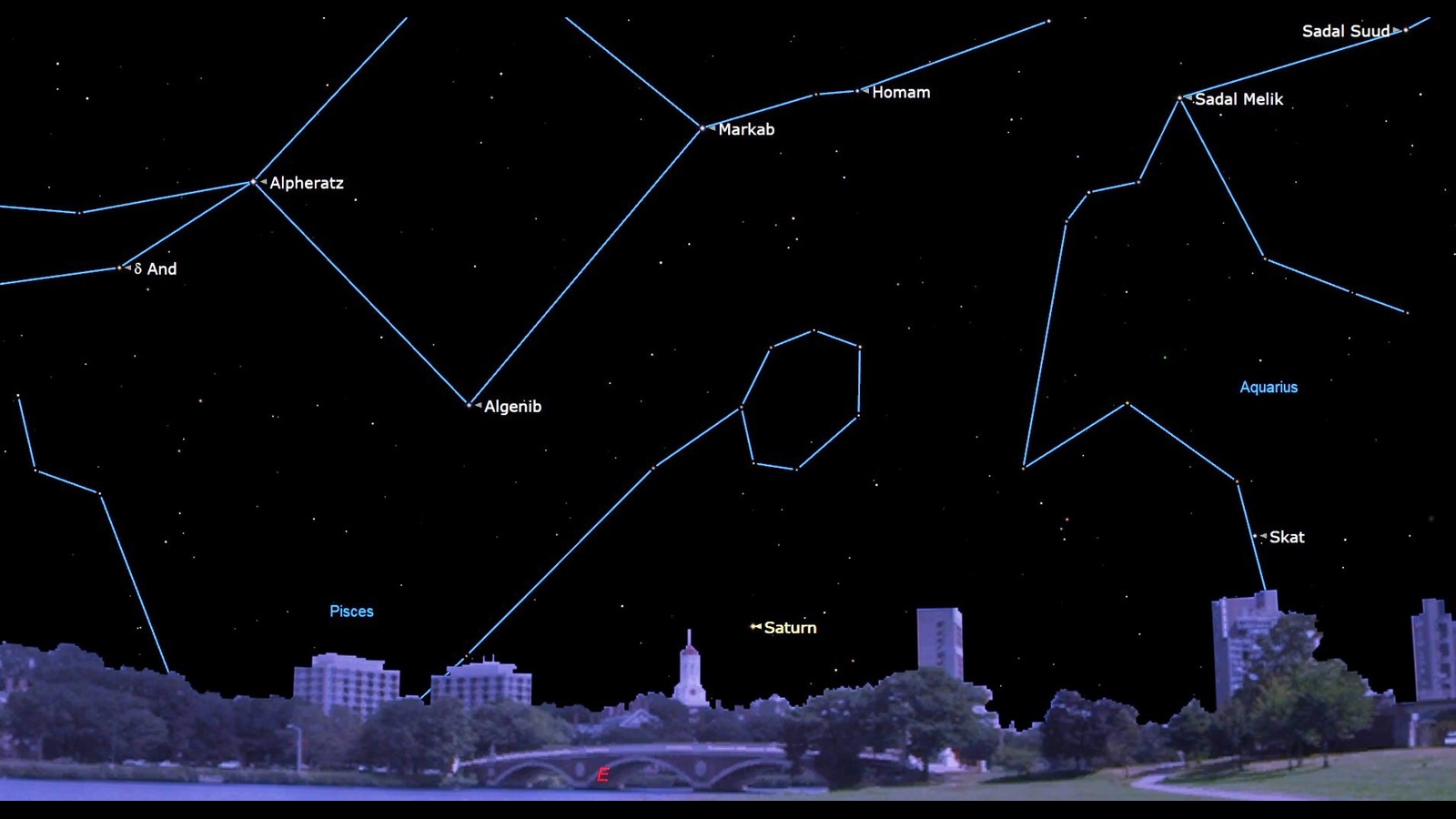
On the nights around Wednesday, July 9, the ringed planet Saturn will finally begin to rise before midnight for observers located at mid-northern latitudes, making Saturn available for evening viewing again after a long absence. During the wee hours, the bright, creamy-yellow planet will climb the southeastern sky below the Great Square of Pegasus. Due to Earth's motion around the sun, the stars and distant planets rise about 4 minutes earlier each day, or about half an hour earlier with each passing week. Saturn will be returning just a few weeks before the red dot of Mars disappears into the western twilight. Then Saturn will reign until Jupiter enters the evening sky around mid-October.
Thursday, July 10: Full Thunder Moon

The moon will reach its full phase on Thursday, July 10, at 4:37 p.m. EDT or 1:37 p.m. PDT and 20:37 GMT. The July full moon, commonly called the Buck Moon, Thunder Moon, or Hay Moon, always shines in or near the stars of Sagittarius or Capricornus. The indigenous Ojibwe people of the Great Lakes region call this moon Abitaa-niibini Giizis, the Halfway Summer Moon, or Mskomini Giizis, the Raspberry Moon. The Cherokees call it Guyegwoni, the Corn in Tassel Moon. The Cree Nation of central Canada calls the July full moon Opaskowipisim, the Feather Moulting Moon (referring to wild waterfowl habits), and the Mohawks call it Ohiarihkó:wa, the Fruits are Ripened Moon. The moon only appears full when it is opposite the sun in the sky, so full moons always rise in the east as the sun is setting, and set in the west at sunrise. Since sunlight is hitting the moon face-on at that time, no shadows are cast. All the variations in brightness you see arise from differences in the reflectivity, or albedo, of the lunar surface rocks. Summertime full moons are as low in the sky as the winter noonday sun.
Saturday, July 12 - The Summer Triangle (all night)
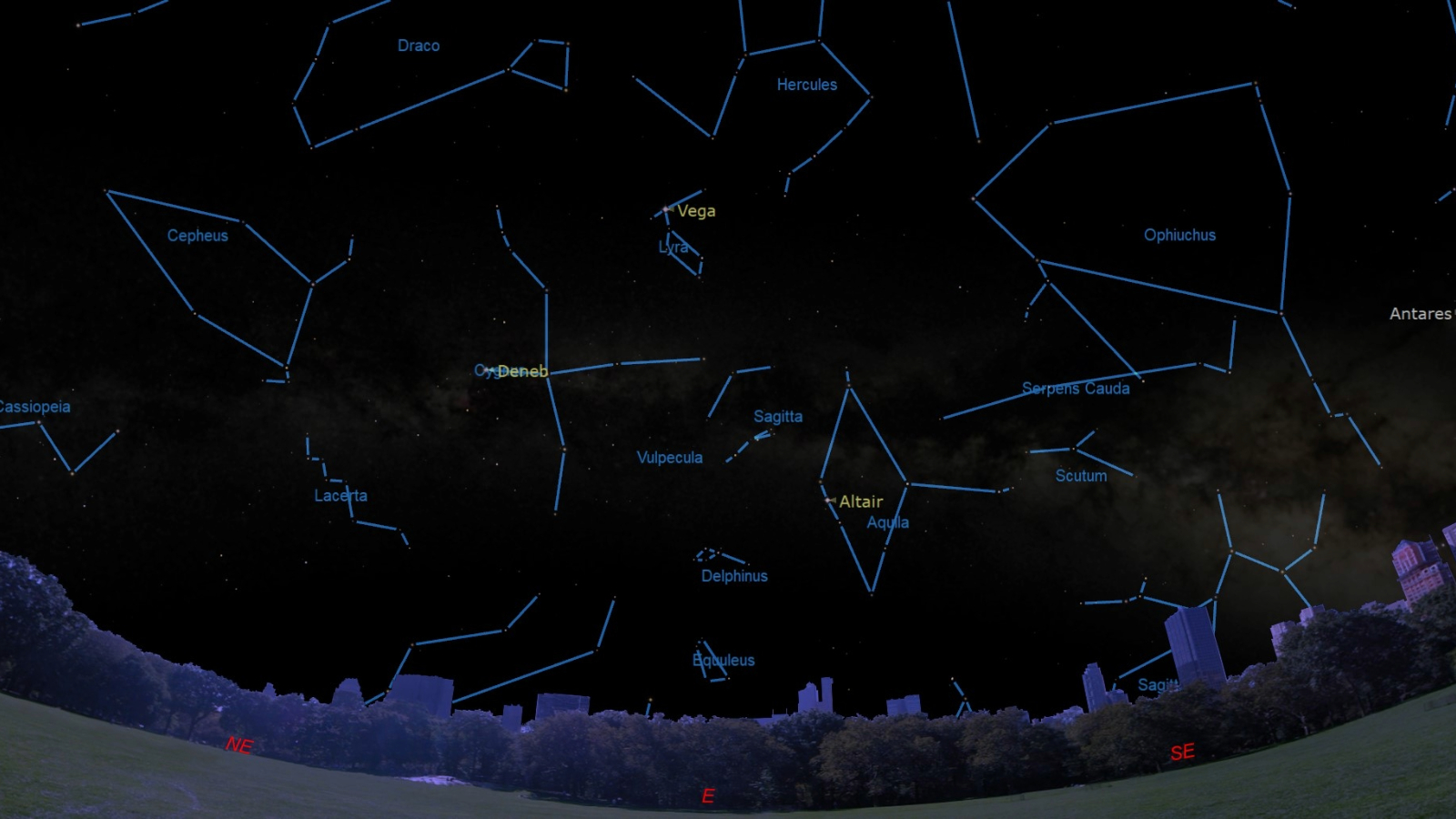
After dusk in mid-July, the first stars to appear in the darkening eastern sky are Vega, Deneb, and Altair. Those three bright, white stars form the Summer Triangle asterism - an annual feature of the summer sky that remains visible until the end of December! The highest and most easterly of the trio is Vega, in Lyra. At magnitude 0.03, Vega is the brightest star in the summer sky, mainly due to its relative proximity. It's only 25 light-years away from the sun. Magnitude 0.75 Altair, in Aquila, occupies the lower right (southern) corner of the triangle. Altair is 17 light-years from the sun. By contrast, Deneb, which shines somewhat less brightly at magnitude 1.25, is a staggering 2,600 light-years away from us, but it shines so brightly because of its greater intrinsic luminosity. Once the bright moon departs next week, watch for the Milky Way passing between Vega and Altair and through Deneb.
Monday, July 14 - Saturn stands still (early hours)
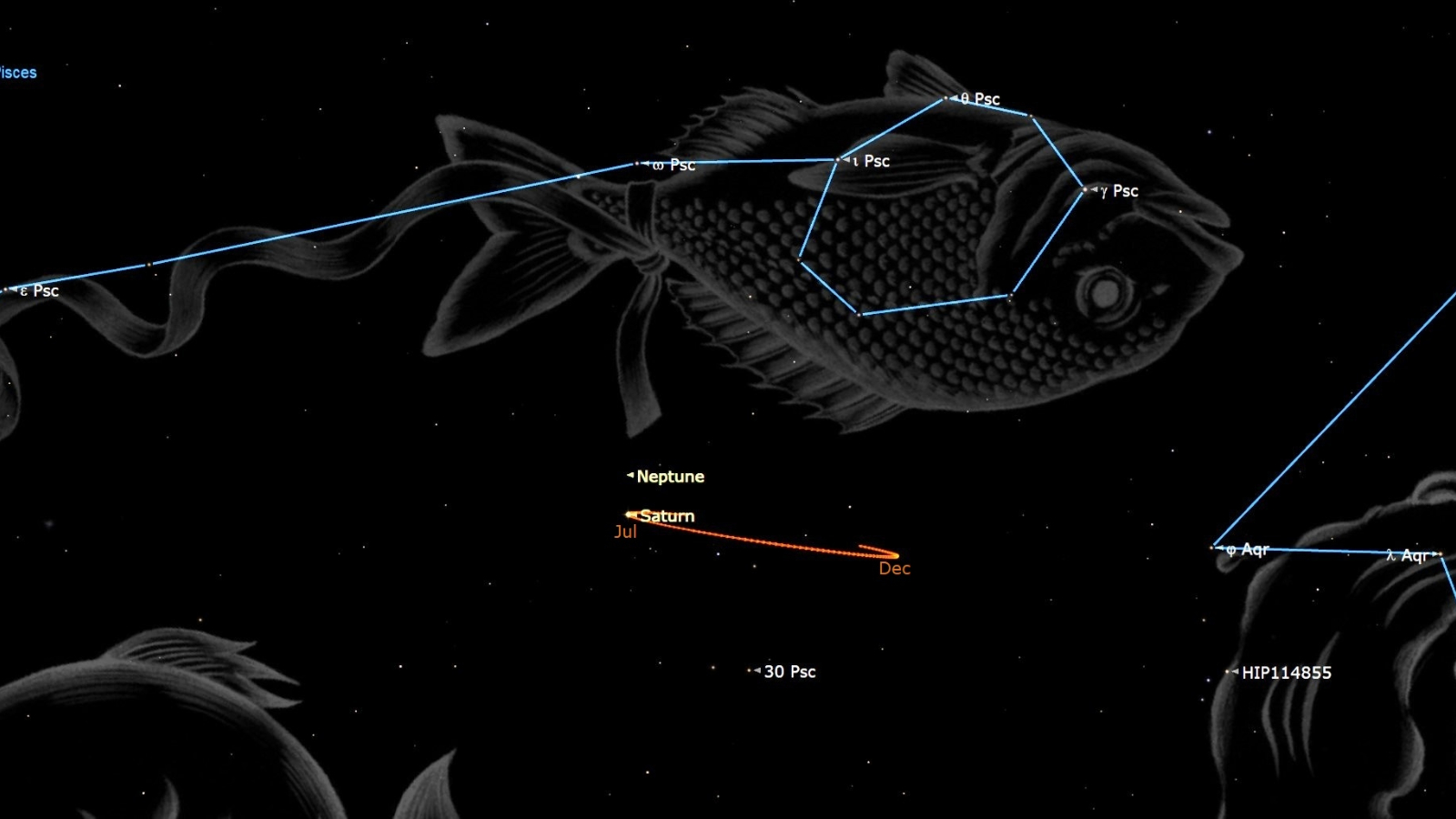
On Monday morning, July 14, the regular eastward motion of Saturn through the background stars of western Pisces will slow to a stop as it prepares to execute a westerly retrograde loop (red curve) that will last until the end of November. The apparent reversal in Saturn's motion is an effect of parallax produced when Earth, on a faster orbit closer to the sun, passes the Ringed Planet on the "inside track". Saturn's retrograde loop will altogether cover about a palm's width (or 7 degrees) of the celestial sphere, though there aren't any bright stars near Saturn to make that motion obvious.
Tuesday, July 15 - Bright moon shines above Saturn and Neptune (overnight)
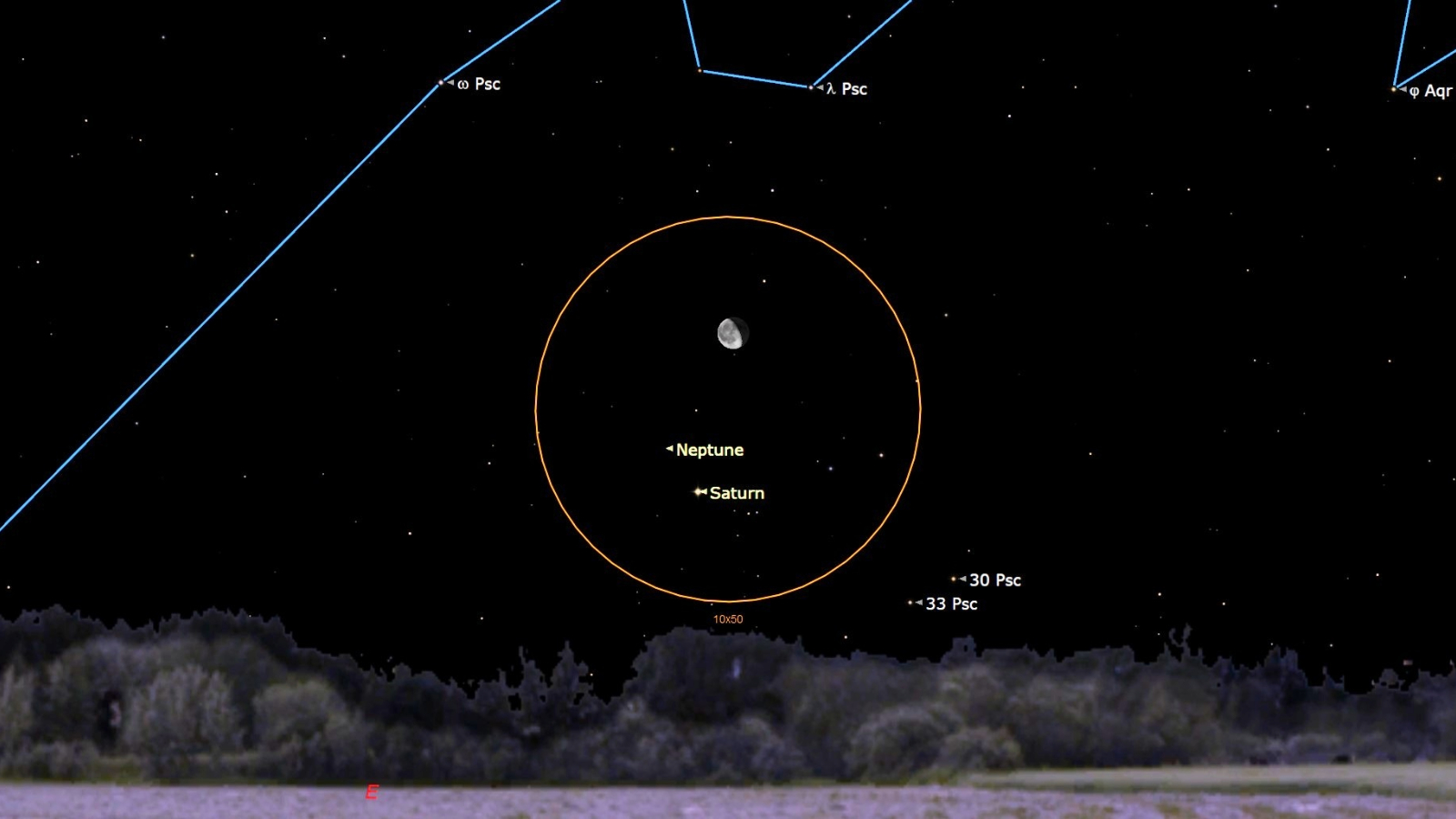
A short time after the bright, waning gibbous moon clears the treetops in the east around midnight on Tuesday evening, July 15, the prominent, yellowish dot of Saturn will climb to join it, close enough to the moon for them to share the view in binoculars (orange circle). The very faint blue planet Neptune will be positioned just a finger's width above Saturn, but a telescope will be required to see it well. The trio will cross the sky together and shine about halfway up the southern sky as dawn breaks on Wednesday morning.
Thursday, July 17 - Third Quarter Moon

The moon will complete three-quarters of its orbit around Earth, measured from the previous new moon, on Thursday, July 17, at 8:38 p.m. EDT or 5:38 p.m. PDT, which converts to Friday at 02:52 GMT. At the third (or last) quarter phase, the moon appears half-illuminated on its western, sunward side. It will rise around midnight local time, and then remain visible until it sets in the western daytime sky in early afternoon. Third quarter moons are positioned ahead of the Earth in our trip around the Sun. About 3½ hours later, Earth will occupy that same location in space. The week of dark, moonless evening skies that follow this phase are the best ones for observing deep sky targets.
Friday, July 18 - The stinging Scorpion (evening)
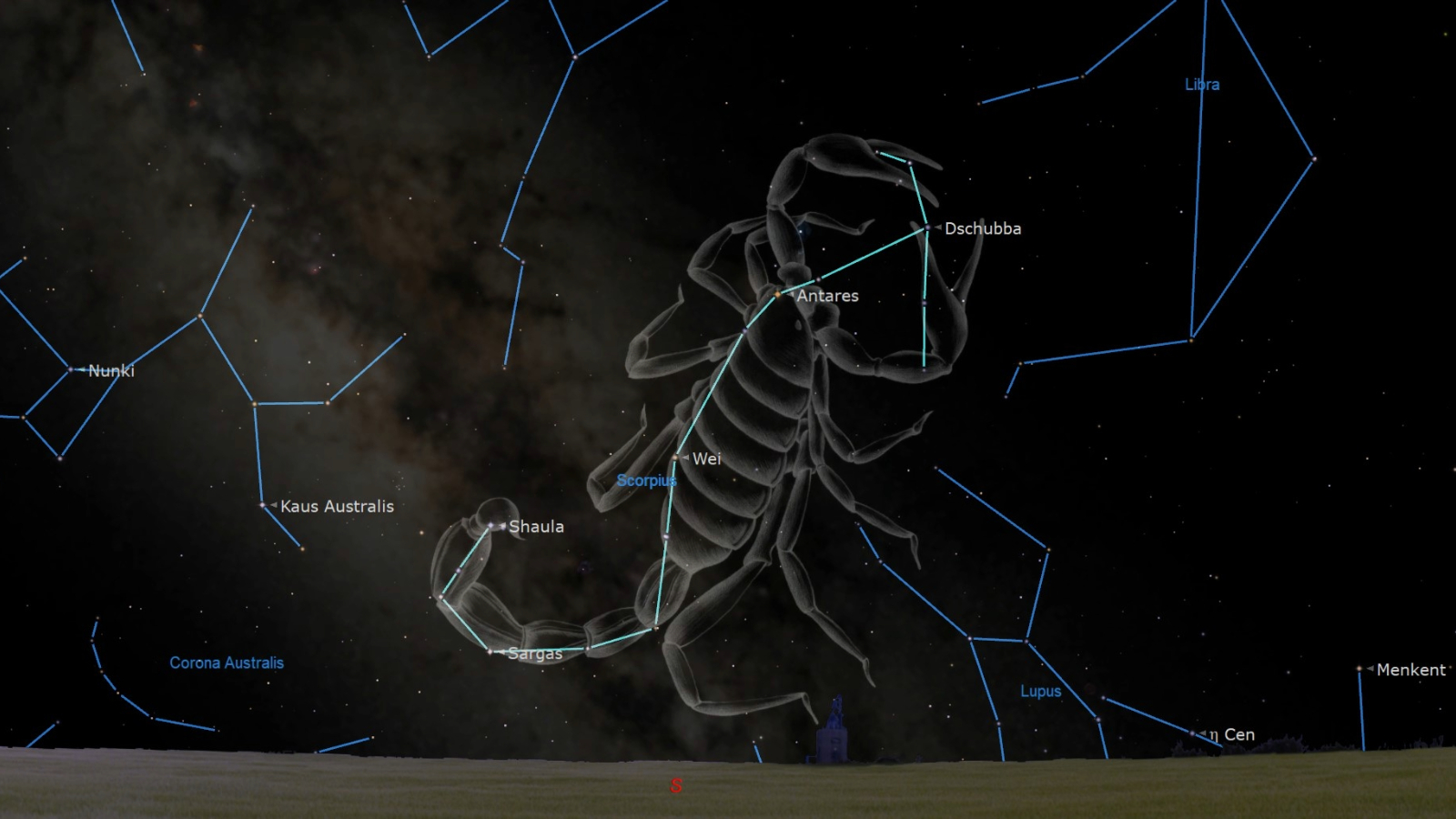
After dusk in mid-July, the distinctive constellation of Scorpius, the Scorpion, reaches its peak elevation over the southern horizon. The constellation's brightest star is orange-tinted Antares, the "Rival of Mars". Several medium-bright, white stars arranged in a roughly vertical line to the west of Antares mark the creature's claws on modern sky charts; however, the major stars of neighboring Libra used to perform that role. The rest of the scorpion extends to the south and curls to the left (celestial eastward) into the Milky Way, terminating with the bright double star Shaula, which marks its poisonous stinger. Observers at high mid-northern latitudes might not be able to see the southernmost stars of the constellation.
Sunday, July 20 - Crescent moon crosses the Pleiades (pre-dawn)

In the eastern sky before dawn on Sunday morning, July 20, the pretty, waning crescent moon will shine very close to the bright little Pleiades Star Cluster (aka The Seven Sisters, Subaru, and Messier 45) in Taurus. The pairing will show nicely in binoculars (orange circle). For skywatchers in the Americas, the moon will pass directly through the cluster's stars starting at about 4:25 a.m. EDT or 08:25 GMT. By the time the moon completes its passage around two hours later, the sky will be brightening in the Eastern and Central time zones, but it will still be dark in the Pacific Time zone. Keep an eye out for the blue-green speck of Uranus to the lower right of the Pleiades all year.
Monday, July 21 - Pretty moon poses with Venus and Jupiter (before sunrise)

After 24 hours of additional eastward motion, the more slender crescent of the waning moon will make a lovely sight while it shines above the brilliant planet Venus in the east before sunrise on Monday, July 21. The pair can be enjoyed and photographed between the time that Venus rises at about 3 a.m. local time and sunrise. The very bright planet Jupiter will gleam to their lower left once it rises at around 4 a.m. local time. On Tuesday morning, the moon will shift to a position between Jupiter and Venus.
Wednesday, July 23 - Sliver of moon meets Jupiter (before sunrise)

The old crescent moon will complete its visit with the bright morning planets on Wednesday, July 22, when its slim, 2.5%-illuminated sliver will shine less than a palm's width to the left (or 5 degrees to the celestial northeast) of brilliant Jupiter. Before the sun begins to rise, you can place Jupiter on the right edge of your binoculars' field of view (orange circle) and find the moon on the left.
Thursday, July 24 - New Moon

On Thursday, July 24, at 3:11 p.m. EDT or 12:11 p.m. PDT, or 19:11 GMT, the moon will officially reach its new moon phase. At that time, our natural satellite will be located in Cancer, 3.4 degrees north of the sun. While new, the moon is travelling in space between Earth and the sun. Since sunlight can only illuminate the far side of the moon, and the moon is in the same region of the sky as the sun, it becomes completely hidden from view from anywhere on Earth for about a day (unless there's a solar eclipse). After the new moon phase, Earth's celestial night-light will return to shine as a crescent in the western evening sky.
Friday, July 25 - Pluto at opposition (all night)
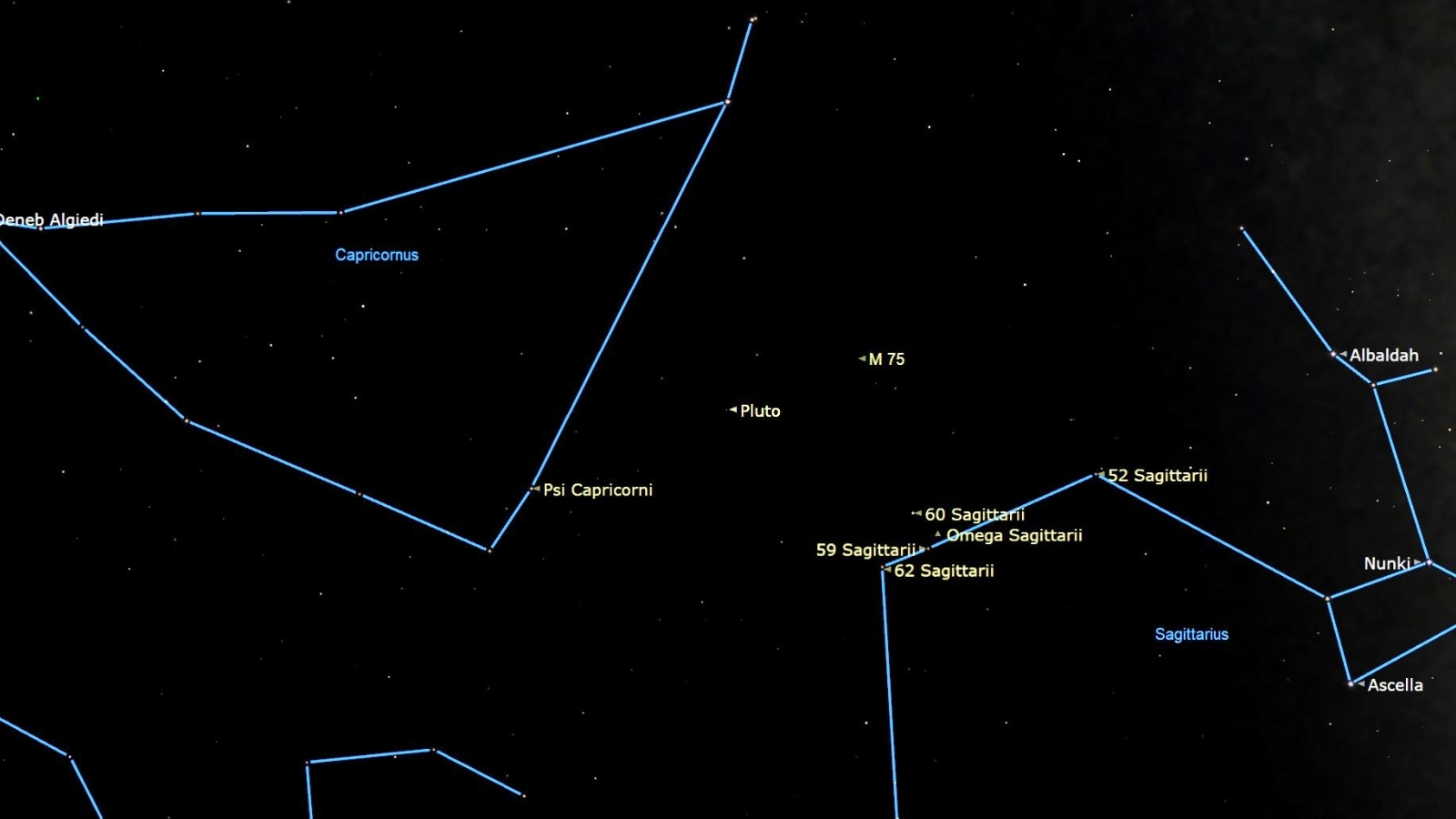
On the nights surrounding Friday morning, July 25, the dim and distant dwarf planet designated (134340) Pluto will reach opposition for 2025. On that date, the Earth will be positioned between Pluto and the sun, minimizing our distance from that outer world and maximizing Pluto's visibility. While at opposition, Pluto will be located 3.28 billion miles, 5.28 billion km, or 285 light-minutes from Earth. Unfortunately, it will shine with an extremely faint visual magnitude of +14.4 that is far too dim for visual observing through a small backyard telescope. Pluto will be located in southwestern Capricornus, about a palm's width to the upper right (or 5.9 degrees to the celestial WNW) of the medium-bright star Psi Capricorni and to the lower left of the globular star cluster Messier 75. Even if you can't see Pluto directly, you will know that it is there.
Saturday, July 26 - Slim crescent moon near Regulus (after sunset)
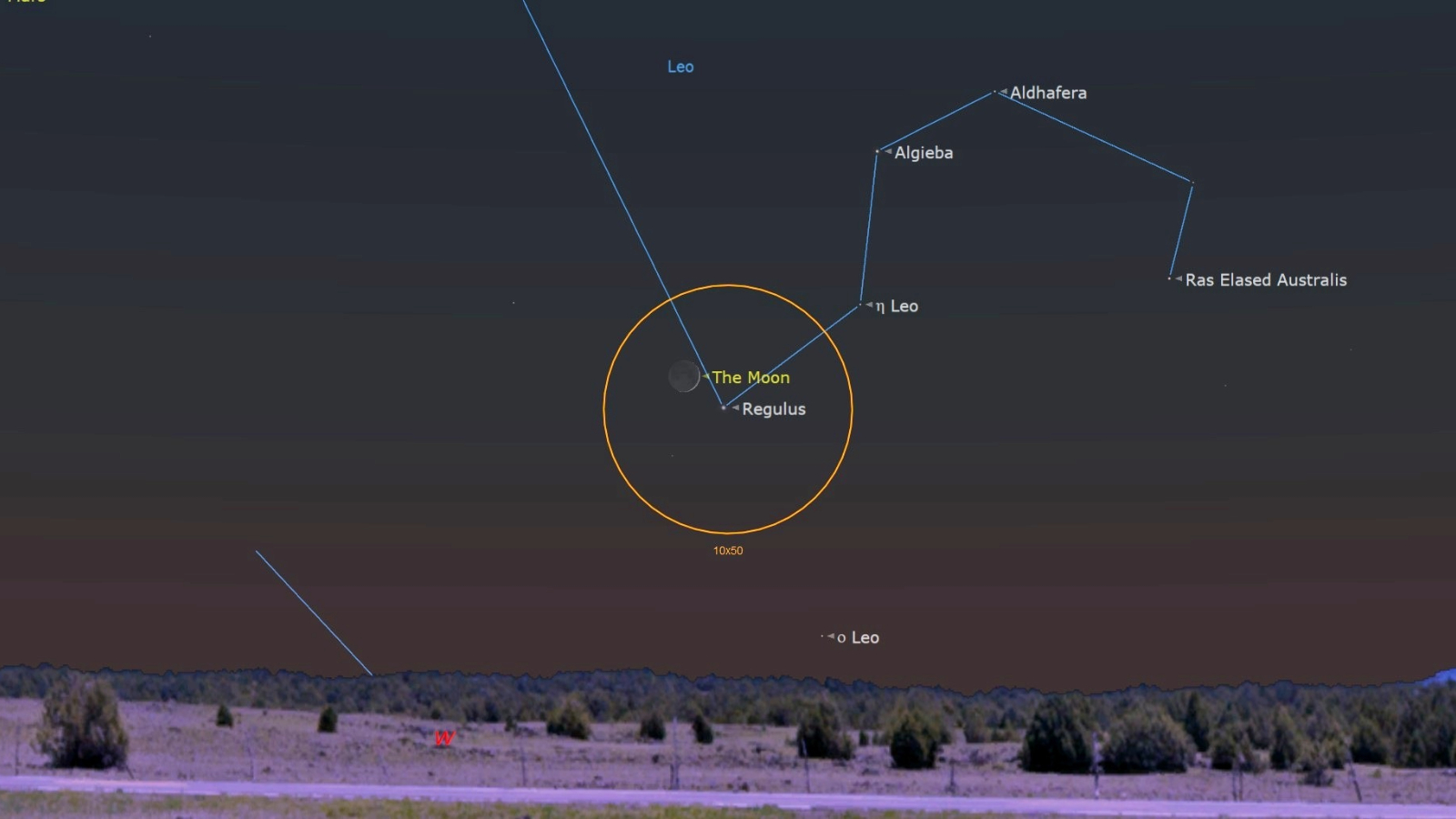
For a short time after sunset on Saturday, July 26, the extremely slender crescent of the young moon will shine above the western horizon. As the sky darkens, Leo's brightest star Regulus, will appear just to the lower right (or celestial west) of the moon — close enough for them to share the view in binoculars (orange circle). Observers closer to the tropics, where the ecliptic will be more vertical, will see their conjunction more easily.
Monday, July 28 - Crescent moon flees Mars (after sunset)
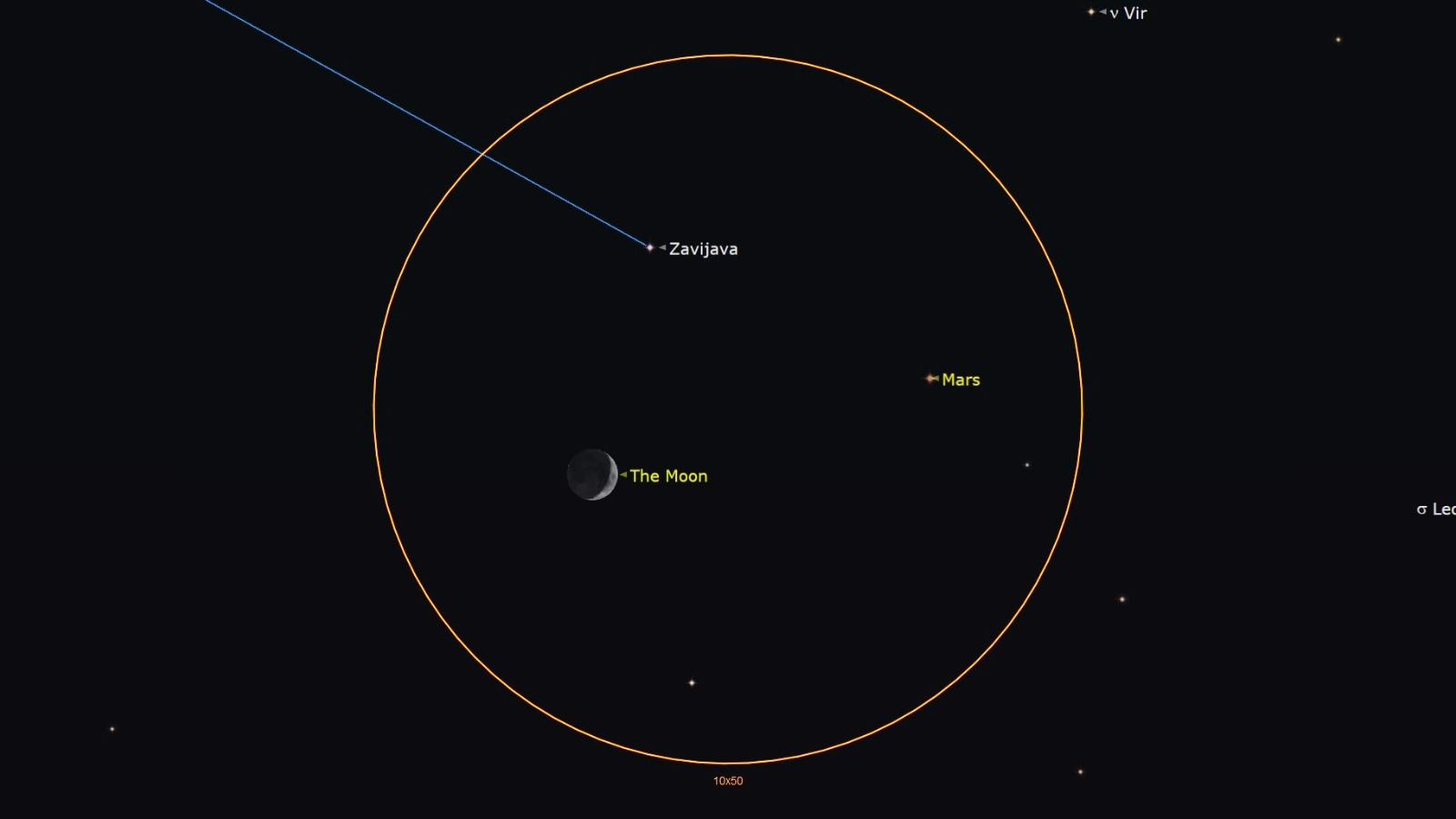
As the sky begins to darken after dusk on Monday, July 28, look low in the western sky for reddish Mars shining several finger widths to the upper right (or 3 degrees to the celestial north) of the waxing moon's slender crescent — close enough for them to share the view in binoculars (orange circle). Since the moon continuously slides east by its own diameter every hour, observers in Europe and Africa will see the moon close below Mars, while those in the western Americas and the Pacific Ocean region will see the moon farther to the left of Mars.
Tuesday, July 29 - Southern Delta-Aquariids meteor shower peaks (early hours)
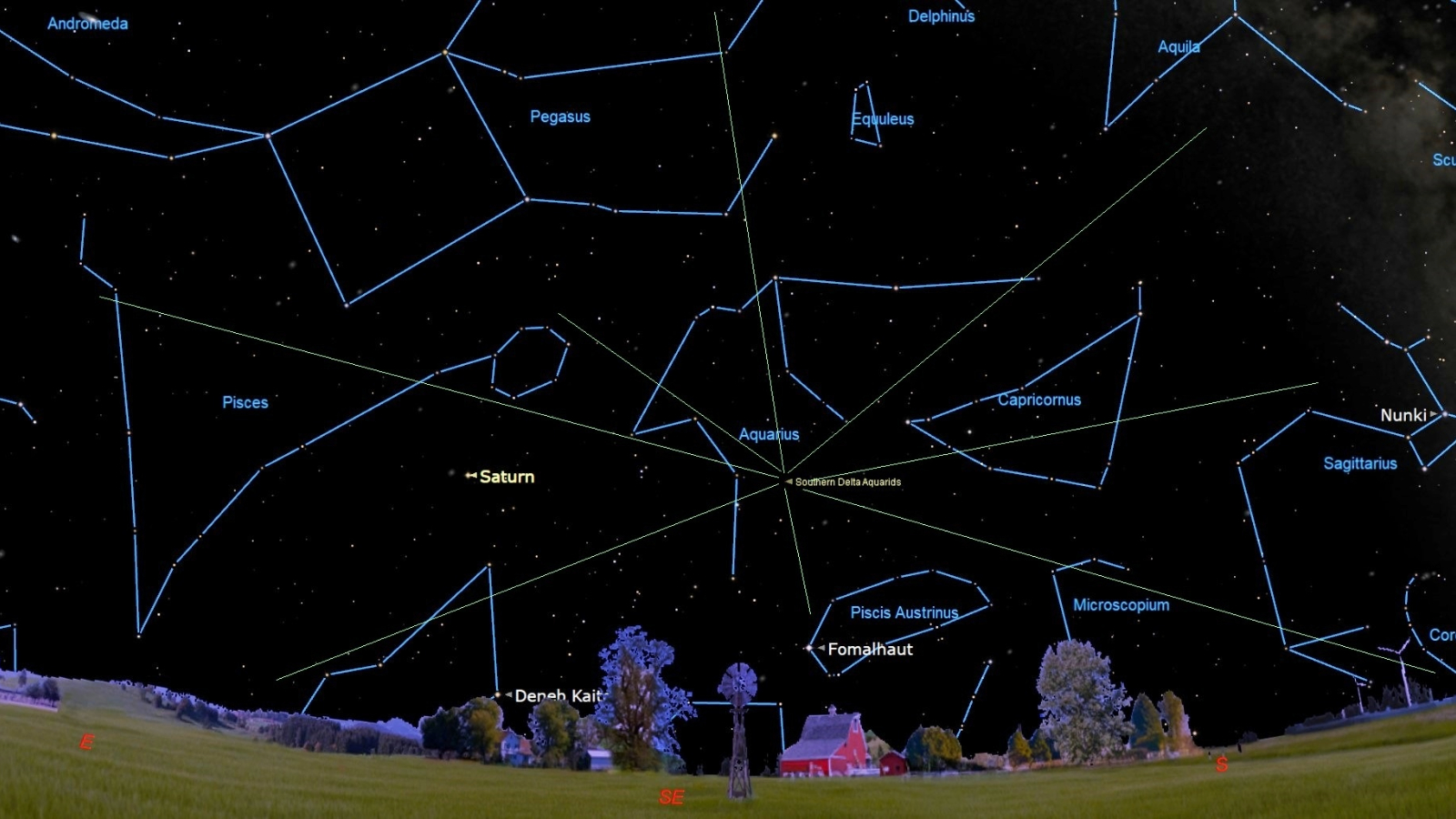
The annual Southern Delta-Aquariids meteor shower lasts from July 18 to August 21. In 2025, it will peak during the wee hours of Tuesday morning, July 29, in the Americas, but it is quite active for a week surrounding the peak night. The best viewing time will run from late Monday evening until the sky starts to brighten on Tuesday morning. The waxing crescent moon will not affect the shower this year. The Southern Delta-Aquariids shower, produced by debris dropped from the periodic Comet 96P/Machholz, commonly generates 15-20 meteors per hour at the peak. It is best enjoyed from the southern tropics, where the shower's radiant, in southern Aquarius, climbs higher in the sky.
Wednesday, July 30 - Crescent moon near Spica again (evening)
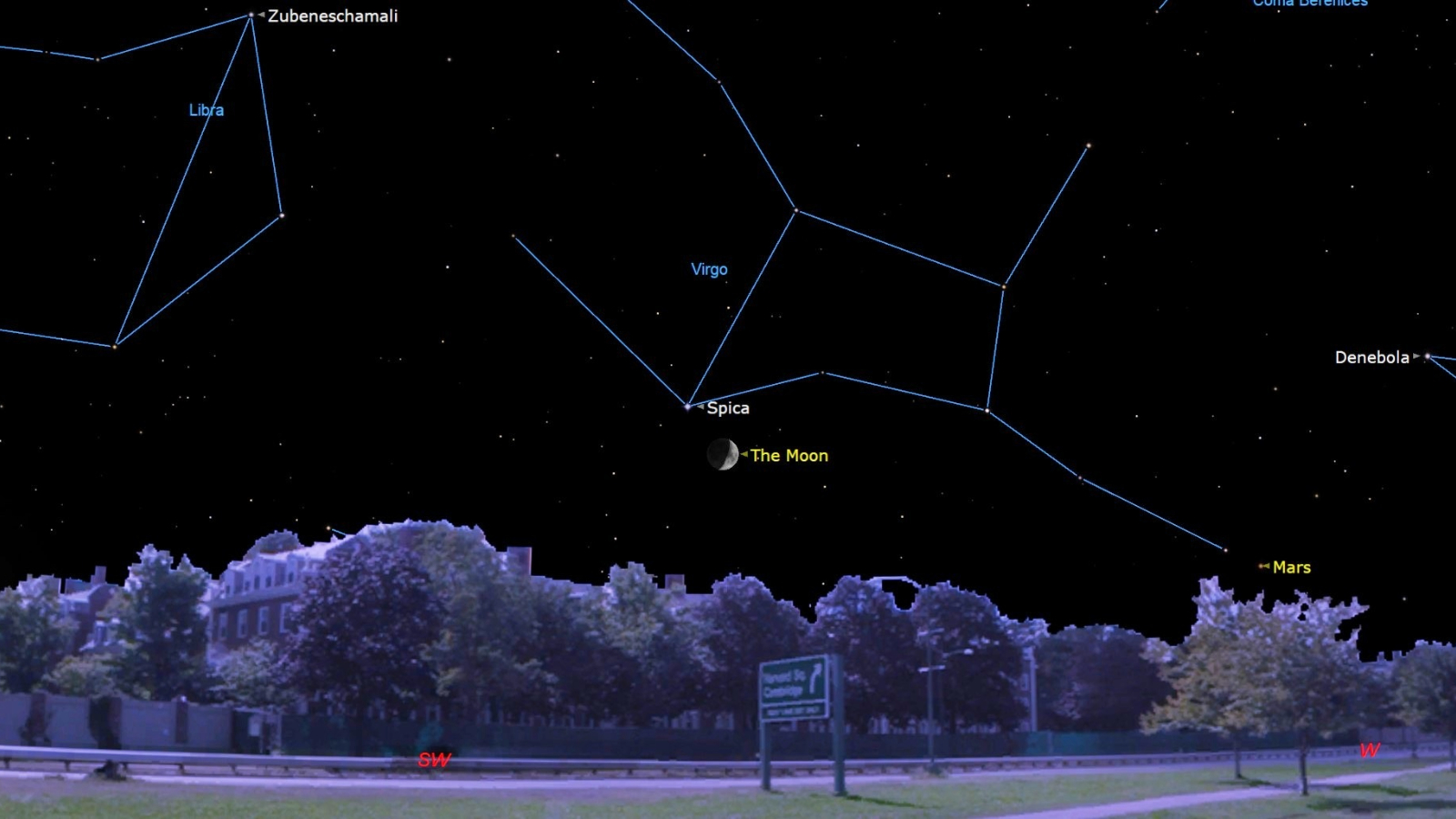
After a previous visit on July 3, the moon's trip around Earth will bring it back to shine near Virgo's brightest star Spica, again on Wednesday evening, July 30. As darkness falls, look low in the western sky for bright, white Spica twinkling several finger widths to the upper left (or celestial east) of the pretty crescent moon. Skywatchers located in more westerly time zones will see the moon closer to the star, clear evidence of our natural satellite's orbital motion.
Visible planets
Mercury

As July opens, Mercury will continue a rather poor appearance in the western sky after sunset for observers located at mid-northern latitudes, but a favorable one when viewing it from the tropics and farther south. The innermost planet will reach its widest angle 25.9 degrees east of the sun on July 3 and then remain just above the western horizon for a short period after sunset until about mid-month. After that, it will rapidly drop sunward and disappear.
From an initial magnitude of 0.3 on July 1, Mercury will diminish considerably in brightness through the month's end. Viewed in a telescope (but only after the sun has completely set), Mercury's orbital motion toward inferior solar conjunction on July 31 will reduce its phase from 45%-illuminated to a slim crescent, and grow its apparent size from 7.8 to nearly 11 arc-seconds. Mercury will skim the southern edge of the Beehive cluster in Cancer for several evenings surrounding July 2, though the conjunction will be best viewed in binoculars from equatorial latitudes.
Venus

During July, Venus will continue to dominate the eastern pre-dawn sky from the time it rises, shortly before 3 a.m. local time, until sunrise. Venus' easterly motion through Taurus will reduce its angle from the sun by 5 degrees and carry it 2.4 degrees south of far fainter Uranus and the nearby Pleiades cluster on July 4. As it steadily increases its distance from Earth during July, Venus' brilliance will slightly decrease.
Over the same interval, a telescope will show its disk waxing from 64% to 75% illuminated and its apparent size shrinking from 17.8 to 14.4 arc-seconds. Early risers can enjoy Venus gleaming above Aldebaran and the stars of the Hyades Cluster for about a week centered on July 11. Bright Jupiter will rise to join Venus after mid-month, setting up a lovely photo opportunity when the waning crescent moon joins them from July 21 to 23
Mars
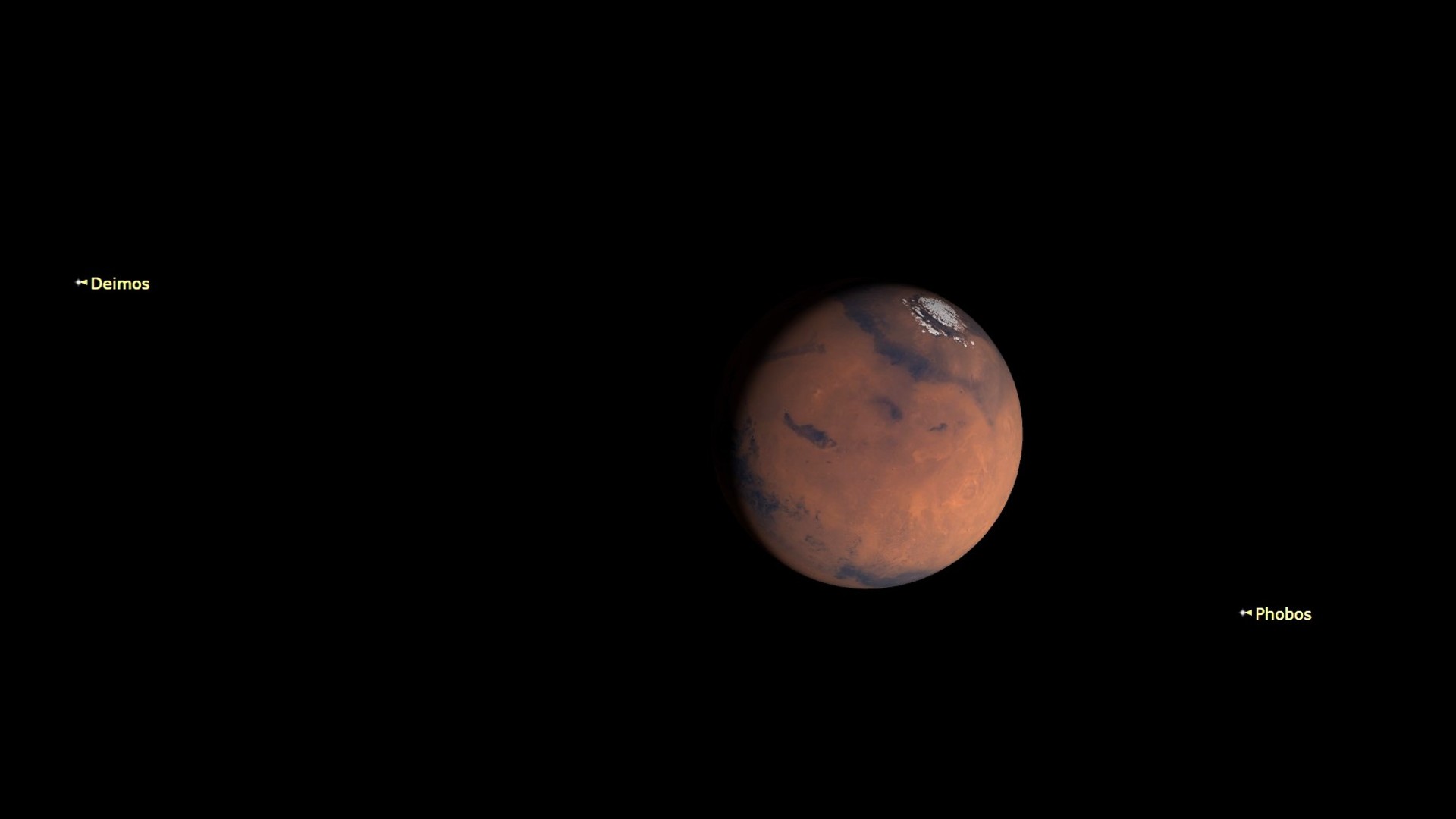
Mars will continue to shine in the lower part of the western sky after dusk during July, though its decreasing angle from the sun will shorten its observing window daily. After a close conjunction with Regulus in late June, the reddish planet will race east across southern Leo and enter Virgo on July 28. Mars' steadily increasing distance from Earth will slightly reduce its brightness from magnitude 1.5 to 1.6 and shrink its 94%-illuminated disk size from 4.9 to 4.4 arc-seconds. After sunset on July 28, the waxing crescent moon will shine several degrees to the lower left of Mars.
Jupiter
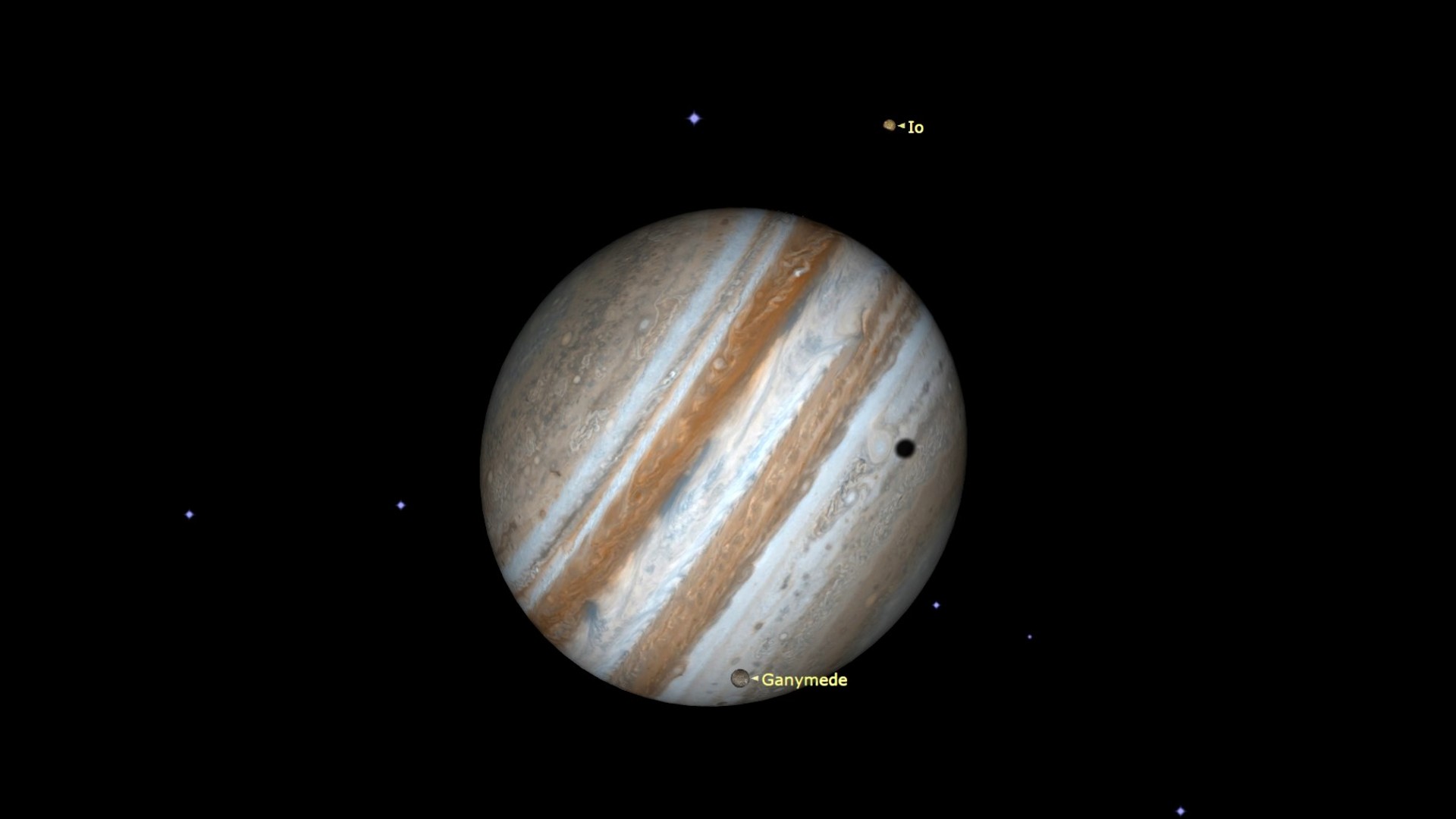
Following its solar conjunction on June 24, bright, magnitude -1.9 Jupiter will stretch far enough west of the sun for it to appear just above the eastern horizon before sunrise starting around mid-July — joining much brighter Venus.
By the end of the month, Jupiter will rise with the stars of Gemini around it, and its angle from Venus will shrink to 12 degrees. The pretty, waning crescent moon will make for some lovely photo opportunities when it passes Venus and approaches Jupiter from July 21 to 23.
Saturn

After the opening days of July, Saturn will begin to rise in the east around midnight local time. As its rising time advances daily, it will climb high enough to produce fine telescope views of the ringed planet from late evening until dawn. Saturn's eastward motion through western Pisces will slow to a stop on July 14 when it begins a 7-degree wide retrograde loop that will last until late November. Saturn will brighten from magnitude 1.0 to 0.85 during July.
In a telescope, its disk and rings will grow a little in apparent size. Only four months after its ring-plane crossing in March, Saturn's rings will remain narrow and its moons will continue to travel close to its ring plane, producing shadow transits of its largest moon Titan ,every 16 days. Saturn will be accompanied by 500 times fainter, magnitude 7.8 Neptune, which will appear as a dull blue "star" shining only 1 degree to its north. The waning gibbous moon will be positioned several degrees above (or celestial north of) Saturn on July 16.
Uranus
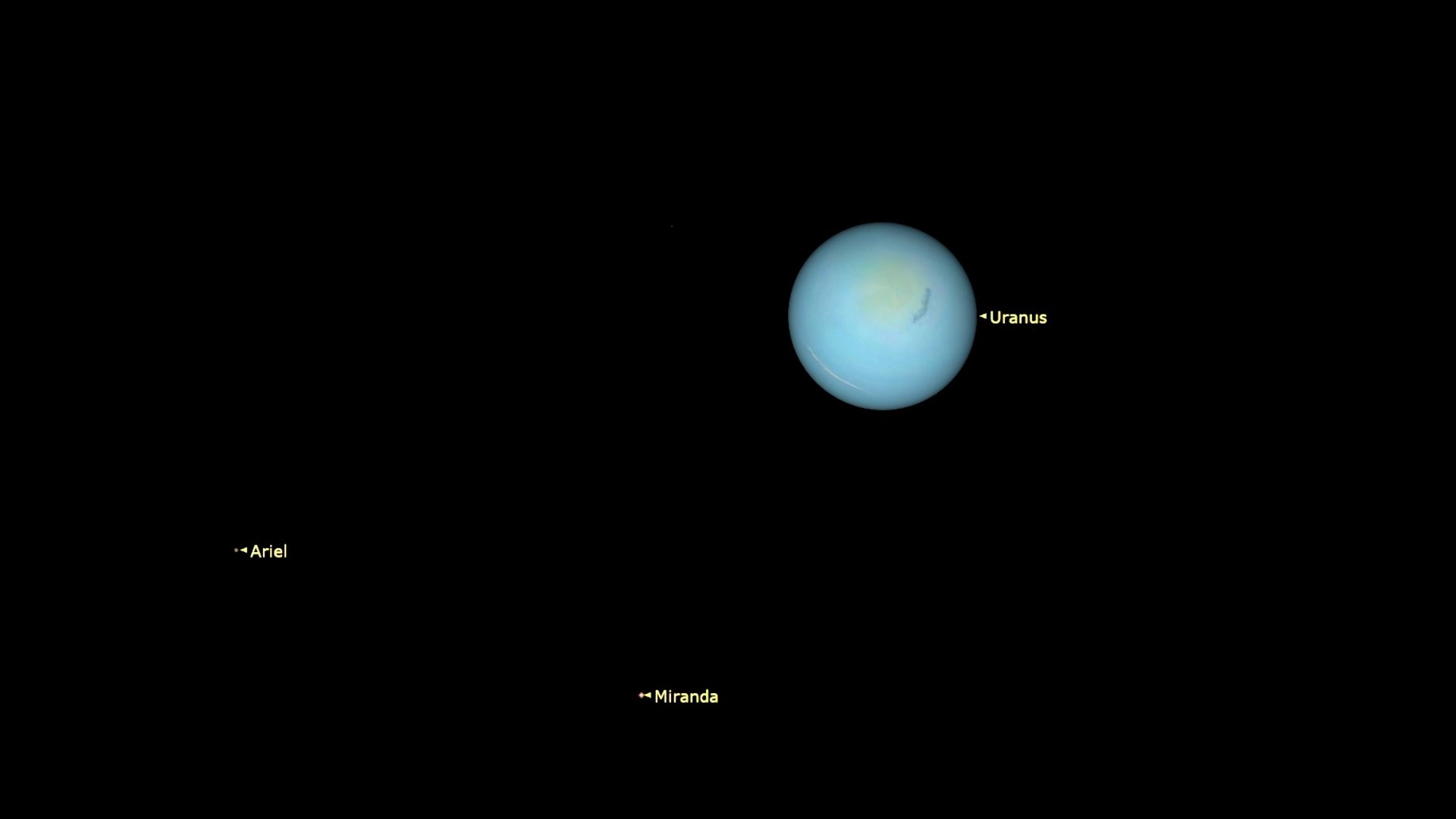
During July, Uranus will rise in the east with the stars of Taurus during the wee hours and attain enough elevation for telescope viewing before the onset of dawn twilight. The planet will spend this year positioned less than a binocular's field to the lower right (or about 4 degrees to the celestial SSW) of the prominent Pleiades star cluster.
During July, magnitude 5.8 Uranus can be spotted as a blue-green speck in binoculars and as a small 3.5 arc-seconds-wide disk through any telescope. On July 4, the far brighter planet Venus will pass 2.4 degrees to the south of Uranus. On July 20, the waning crescent moon will shine near Uranus while making a passage through the Pleiades.
Neptune

Magnitude 7.9 Neptune will spend July climbing the southeastern sky from late evening until dawn and appearing as a dull blue "star" located only 1 degree north of 500 times brighter Saturn in southwestern Pisces. On July 5, the outermost planet will commence a retrograde loop that will last until mid-December. The waning gibbous moon will shine near Neptune and Saturn on July 16.
Join our Space Forums to keep talking space on the latest missions, night sky and more! And if you have a news tip, correction or comment, let us know at: community@space.com.
Breaking space news, the latest updates on rocket launches, skywatching events and more!
Chris Vaughan, aka @astrogeoguy, is an award-winning astronomer and Earth scientist with Astrogeo.ca, based near Toronto, Canada. He is a member of the Royal Astronomical Society of Canada and hosts their Insider's Guide to the Galaxy webcasts on YouTube. An avid visual astronomer, Chris operates the historic 74˝ telescope at the David Dunlap Observatory. He frequently organizes local star parties and solar astronomy sessions, and regularly delivers presentations about astronomy and Earth and planetary science, to students and the public in his Digital Starlab portable planetarium. His weekly Astronomy Skylights blog at www.AstroGeo.ca is enjoyed by readers worldwide. He is a regular contributor to SkyNews magazine, writes the monthly Night Sky Calendar for Space.com in cooperation with Simulation Curriculum, the creators of Starry Night and SkySafari, and content for several popular astronomy apps. His book "110 Things to See with a Telescope", was released in 2021.
You must confirm your public display name before commenting
Please logout and then login again, you will then be prompted to enter your display name.


